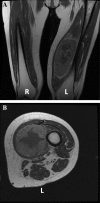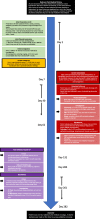Undifferentiated epithelioid sarcoma presenting as a fever of unknown origin: a case report
- PMID: 30684969
- PMCID: PMC6348079
- DOI: 10.1186/s13256-018-1951-1
Undifferentiated epithelioid sarcoma presenting as a fever of unknown origin: a case report
Abstract
Background: Fever of unknown origin is often a diagnostic dilemma for clinicians due to its extremely broad differential. One of the rarer categories of disease causing fever of unknown origin is malignancies; of these, soft tissue sarcoma is one of the least common. Soft tissue sarcomas make up < 1% of all adult malignancies and often do not present with any systemic manifestations or neoplastic fevers.
Case presentation: A 73-year-old Caucasian woman presented with a 2-week history of fever and profound fatigue. The only other symptom she endorsed was a transient history of left knee pain, initially thought to be unrelated. There was no clear cause on initial examination and routine investigations, but her C-reactive protein was significantly elevated at 207 mg/L. Blood cultures and a urine culture were drawn. She was admitted to hospital for further investigation and placed on empiric antibiotics. Her blood cultures were negative, but she had one further fever in hospital. Computed tomography scans did not yield a cause of her fever. No vegetations were seen on echocardiography. Antibiotics were stopped as she did not seem to have an acute infectious cause of her fever. No new symptoms developed. She felt well enough to proceed with out-patient follow up and was discharged after 8 days in hospital. At 1-month post-discharge: no resolution of symptoms, but she endorsed a recurrence of her left knee pain. Ultrasound and magnetic resonance imaging revealed a 4.5 × 6.8 × 11.6 cm soft tissue mass, identified as a sarcoma on biopsy. She subsequently underwent a distal femur resection. Final staging was pT2bN0M0. She underwent adjuvant radiation therapy, but was found to have developed metastatic disease.
Conclusion: This case revealed an atypical presentation of a rare soft tissue sarcoma as the cause of the illness. The etiology behind a fever of unknown origin can be difficult to elucidate, making the approach to investigation particularly important. Repeated history-taking and serial physical examinations can be crucial in guiding investigations and ultimately arriving at a diagnosis. In addition, we believe this case highlights the adage that no seemingly innocuous symptom should be left out when working up a condition with such an extensive and complex differential.
Keywords: Complex; Fever of unknown origin (FUO); Malignancy; Rare; Sarcoma; Soft tissue.
Conflict of interest statement
Ethics approval and consent to participate
Not applicable. Consent for participation in this case report, including the use and analysis of patient health information, was obtained from the patient prior to the beginning of this case writing. The ethics guidelines behind the use of personal health information were maintained using information that was properly deidentified prior to dissemination to personnel not directly within the patient’s circle of care.
Consent for publication
Written informed consent was obtained from the patient for publication of this case report and any accompanying images. A copy of the written consent is available for review by the Editor-in-Chief of this journal.
Competing interests
The authors declare that they have no competing interests.
Publisher’s Note
Springer Nature remains neutral with regard to jurisdictional claims in published maps and institutional affiliations.
Figures



References
-
- Brennan MF. Lessons learned from the study of soft tissue sarcoma. Int J Surg. 2013; 10.1016/S1743-9191(13)60005-9. - PubMed
Publication types
MeSH terms
LinkOut - more resources
Full Text Sources
Medical
Research Materials

